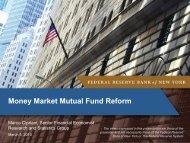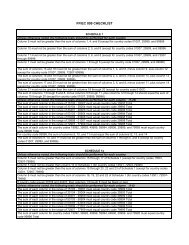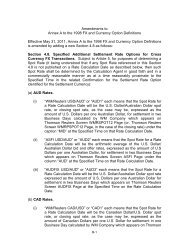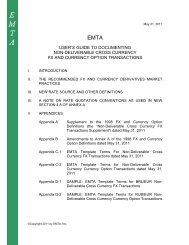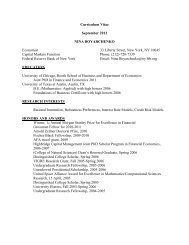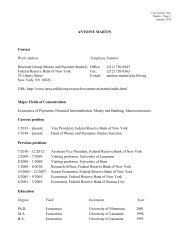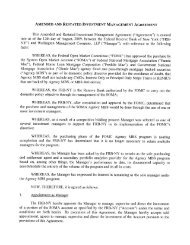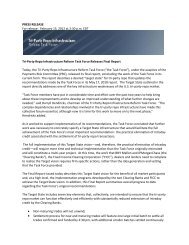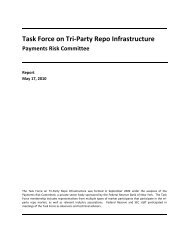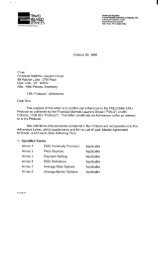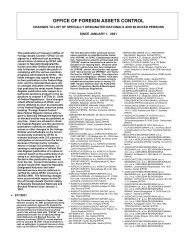Residential Foreclosures in the City of Buffalo, 1990-2000 - Federal ...
Residential Foreclosures in the City of Buffalo, 1990-2000 - Federal ...
Residential Foreclosures in the City of Buffalo, 1990-2000 - Federal ...
You also want an ePaper? Increase the reach of your titles
YUMPU automatically turns print PDFs into web optimized ePapers that Google loves.
Chapter 7: Conclusion and Implications<br />
In this study, we have analyzed a broad range <strong>of</strong> characteristics potentially associated<br />
with foreclosures <strong>in</strong> <strong>Buffalo</strong> over <strong>the</strong> <strong>1990</strong>-<strong>2000</strong> period. Although <strong>the</strong>se characteristics<br />
could be associated with foreclosures <strong>in</strong> a number <strong>of</strong> ways, we did not assess <strong>the</strong> nature<br />
<strong>of</strong> those relationships. But while we did not attempt to determ<strong>in</strong>e <strong>the</strong> causes <strong>of</strong> <strong>the</strong> rise <strong>in</strong><br />
foreclosures, our <strong>in</strong>vestigation sheds light on <strong>the</strong> context <strong>in</strong> which <strong>the</strong>y occurred.<br />
Overall, <strong>Buffalo</strong> has experienced a significant rise <strong>in</strong> residential foreclosures<br />
dur<strong>in</strong>g <strong>the</strong> study period. The <strong>in</strong>crease took place <strong>in</strong> an environment <strong>of</strong> slow growth but<br />
absent any significant negative economic stimulus. However, <strong>the</strong> city cont<strong>in</strong>ued to house<br />
a disproportionate share <strong>of</strong> <strong>the</strong> metro area’s poor. At a time when foreclosures are ris<strong>in</strong>g<br />
nationwide, it is not surpris<strong>in</strong>g that <strong>the</strong> effect would be more noticeable <strong>in</strong> <strong>the</strong> region’s<br />
central city. Evidence suggests that <strong>the</strong> process itself disproportionately affects low- and<br />
moderate-<strong>in</strong>come homeowners because <strong>the</strong>y lack <strong>the</strong> resources both to avert default<br />
dur<strong>in</strong>g difficult economic times and to halt <strong>the</strong> foreclosure process once it has begun.<br />
Such homeowners clearly represent a considerable portion <strong>of</strong> <strong>the</strong> <strong>Buffalo</strong> hous<strong>in</strong>g market.<br />
In addition, it is clear that <strong>the</strong> growth <strong>in</strong> foreclosures is widespread and that <strong>the</strong><br />
factors beh<strong>in</strong>d it are complex. The <strong>in</strong>cidence <strong>of</strong> foreclosure is up significantly <strong>in</strong> all<br />
<strong>Buffalo</strong> communities, and <strong>the</strong> largest <strong>in</strong>creases are found <strong>in</strong> those communities with<br />
relatively few foreclosures <strong>in</strong> <strong>1990</strong>. But while foreclosures are up across <strong>the</strong> city, <strong>the</strong>y<br />
have ma<strong>in</strong>ta<strong>in</strong>ed a consistent spatial pattern, tend<strong>in</strong>g to concentrate <strong>in</strong> a concentric r<strong>in</strong>g<br />
around <strong>the</strong> city’s periphery. This spatial distribution appears to be associated with <strong>the</strong><br />
socioeconomic and hous<strong>in</strong>g characteristics <strong>of</strong> <strong>Buffalo</strong>’s neighborhoods, which <strong>in</strong> turn<br />
have followed generally observed patterns <strong>of</strong> urban transformation.<br />
Neighborhoods<br />
A central f<strong>in</strong>d<strong>in</strong>g <strong>of</strong> our study is that foreclosures were most concentrated <strong>in</strong> <strong>Buffalo</strong>’s<br />
higher <strong>in</strong>come m<strong>in</strong>ority neighborhoods. But above all, this phenomenon appears to be<br />
tied to patterns <strong>of</strong> urban change. For decades, <strong>the</strong> m<strong>in</strong>ority population <strong>in</strong> <strong>Buffalo</strong> has been<br />
migrat<strong>in</strong>g outward from <strong>the</strong> <strong>in</strong>ner city, generally mov<strong>in</strong>g to newer, better conditioned<br />
hous<strong>in</strong>g <strong>in</strong> adjacent neighborhoods. The neighborhoods at <strong>the</strong> peak <strong>of</strong> this transition—<br />
64



